The Best Beaches in the North West of England
Bordering the Irish Sea and spanning three counties, these beaches in the North West make for excellent places to...
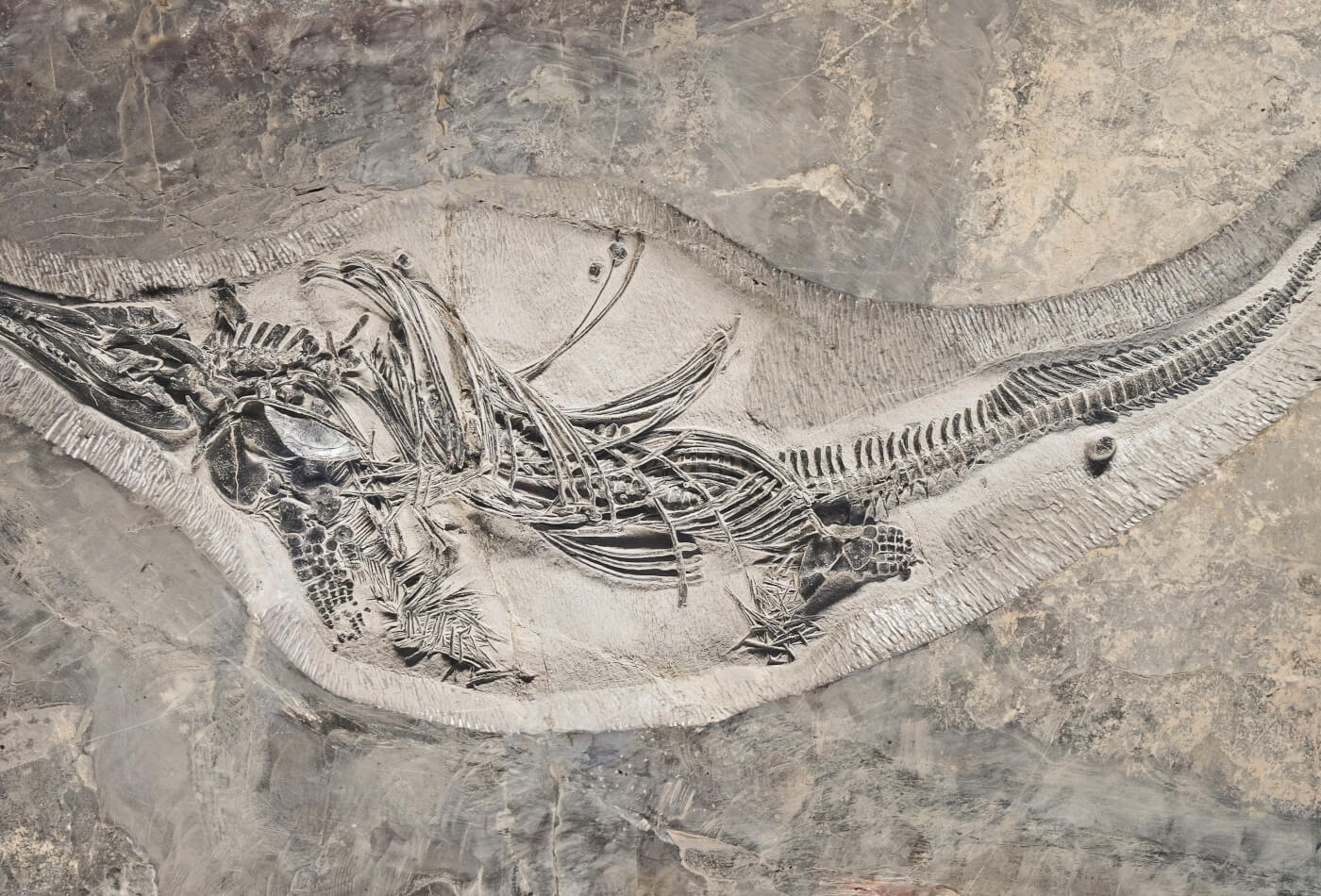
Unearth Britain’s ancient past and learn how to find your very own relics with Sykes Holiday Cottages’ comprehensive UK fossil hunting guide!
Whether you’re a curious beginner or a seasoned enthusiast, the British coastline offers some of the richest and most accessible fossil beds in the world. From ammonites in Dorset to dinosaur footprints on the Isle of Wight, there’s something for everyone with a keen eye and a sense of adventure.
Booking a UK holiday cottage in one of these fantastic locations gives you the perfect opportunity to try your hand at this fasciniting and inisghtful hobby!
Keep scrolling to discover the best spots, expert tips and everything you need to get started with fossil hunting in the UK…
Fossil hunting is a unique and interesting hobby that involves searching for and collecting the preserved remains and traces of ancient plants and animals. Typically found in rocks, cliffs and along beaches all over the world, they can also include shells, bones, imprints of plants and even dinosaur footprints.
In the UK, fossil hunting is a popular outdoor activity thanks to the country’s rich geological history and wide range of accessible coastal sites. In fact, the UK has rocks from almost every geological period, making it one of the best places in the world to find a wide variety of fossils.
And whilst it may seem like a hobby that’s only been around for a few years, the reality is much different. In fact, some of the earliest UK fossil hunters, like Mary Anning, started to make the activity popular from discoveries made during the 19th century.
An activity that requires lots of patience, a keen eye and a basic understanding of where and how fossils form, many beginners start by exploring beaches where natural erosion reveals new specimens regularly. In essence, it’s a hands-on way to learn about ancient life and geology, and with the right approach, it’s accessible to all ages and skill levels.

Those of you that are thinking about getting into fossil hunting in the UK will be pleased to learn that you don’t need a science degree, expensive equipment or any prior experience. Anyone can give it a go, whether you’re planning a day out with the kids or simply looking for a new outdoor hobby.
The country’s coastlines, cliffs and quarries are full of clues from prehistoric life, and many sites are easy to access on foot. With the right location, a bit of patience and a few basic tips, you’ll be well on your way to making your first find!
 What You’ll Need
What You’ll NeedGetting started doesn’t require much. In fact, at many of the beaches listed in this guide, you won’t need anything more than a pair of sharp eyes and a bit of luck. That said, a few simple items can make the experience more enjoyable and increase your chances of finding something special!
• Sturdy Footwear: Most fossil hunting takes place on rocky or uneven ground, so solid walking boots or shoes are essential.
• Protective gloves: Useful for handling sharp rocks or debris.
• A small backpack or container: To safely store and carry any finds.
• A Field Guide or fossil ID book: Helps you identify what you’ve found and understand its origin.
• Hand Lens or Magnifying Glass: Useful for examining small fossils.
• Other Tools (optional): A small geological hammer and chisel can be helpful, but only where collecting is permitted and safe. Always wear safety goggles if using tools.

While fossil hunting is legal in many areas of the UK, it’s important to follow some basic principles to ensure you’re collecting responsibly.
• Stick to Loose Fossils: As a rule of thumb, only collect fossils that have already been washed out of cliffs or rocks and are lying loose on the ground or beach.
• Avoid Damaging Rock Faces: Never hammer into protected cliffs, bedrock or heritage sites. It can be dangerous and is often illegal.
• Check Local Guidelines: Some areas have special rules, particularly Sites of Special Scientific Interest (SSSIs). These sites may allow limited collecting or require permission.
• Report Significant Finds: If you think you’ve discovered something rare or unusual, report it to a local museum, geological society or the Natural History Museum. Who knows… it may be of scientific value!
🛈 You should also check local tide times before you go. Many fossil hotspots are best visited at low tide, and some areas can become cut off quickly as the sea comes in.
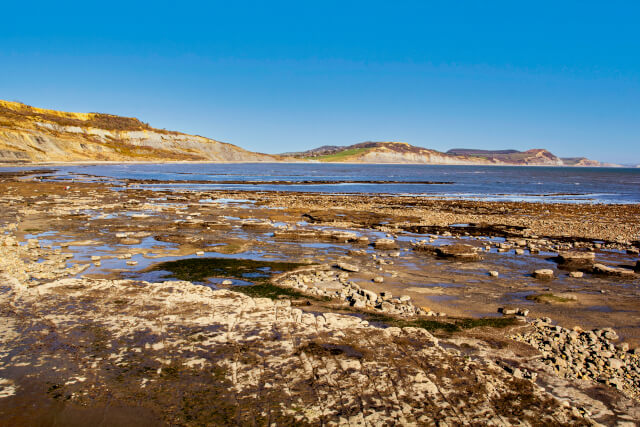
The Jurassic Coast is one of the most iconic fossil-hunting regions in the UK. Stretching for 95 miles along the south coast of England, from Exmouth in East Devon to Studland Bay in Dorset, it is Britain’s only natural UNESCO World Heritage Site. The cliffs here expose a near-continuous sequence of rock layers spanning the Triassic, Jurassic and Cretaceous periods, covering roughly 185 million years of Earth’s history.
Home to some of the best beaches in Dorset, this coastline is particularly rich in marine fossils, including ammonites, belemnites and the remains of ancient reptiles such as ichthyosaurs and plesiosaurs. The natural erosion of the cliffs means that new fossils are regularly revealed, making it a reliable and rewarding place for fossil hunters of all levels. It’s one of the most accessible and educational places for fossil hunting in the UK, with well-trodden paths, local visitor centres and a long-standing connection to the history of palaeontology.
The Jurassic Coast is also a protected environment, so it’s important to follow local guidance when collecting fossils. Much of the area is part of a Site of Special Scientific Interest (SSSI), and responsible collecting is key to preserving its scientific and educational value for future generations. We’d recommend ticking this activity off your winter bucket list, as quieter beaches and rough seas increase your chance of finding something.

• Lyme Regis Beach (DT7 3JF) – Best known for ammonites, belemnites and occasional marine reptile fossils exposed by regular cliff falls.
• Charmouth Beach (DT6 6LS) – A popular spot for finding ammonites, belemnites and ichthyosaur fragments along the foreshore.
• Kimmeridge Bay (BH20 5PF) – Yields well-preserved fossil shells, fish and reptile remains from its distinctive clay cliffs.
• Seatown Beach (DT6 6JU) – Offers a mix of ammonites and other Jurassic marine fossils, often found in fallen shale and nodules.

The Isle of Wight is one of the most important and well-known fossil hunting regions in the UK, particularly for dinosaur discoveries. Often referred to as the “Dinosaur Capital of Britain”, the island has yielded thousands of fossil specimens over the years, including complete skeletons, teeth and footprints. Its rich geological layers, particularly those from the Early Cretaceous period, make it a key site for understanding prehistoric life on land.
The coastline regularly reveals new finds due to natural erosion, especially following winter storms. The mix of accessible and beautiful Isle of Wight beaches, exposed cliffs and inland sites mean fossil hunters have a good chance of uncovering something of interest, whether it’s a small piece of plant material, a fragment of bone or a fossilised shell. The Isle of Wight also has a strong fossil hunting community, with museums and guided walks available for beginners.
Fossil hunting on the island is well-supported by local resources, but it’s still important to follow responsible collecting practices. Some areas fall within designated SSSIs or are located near protected cliffs, so checking local guidance and collecting only from loose material is essential. The Isle of Wight remains one of the most exciting destinations for fossil hunting in the UK, especially for those interested in the age of the dinosaurs.

• Compton Beach (PO30 4HB) – Known for its visible dinosaur footprints and occasional bone fragments exposed at low tide.
• Whitecliff Bay Beach (PO35 5QB) – Offers a range of fossilised shells, sponges and plant material from the Eocene period.
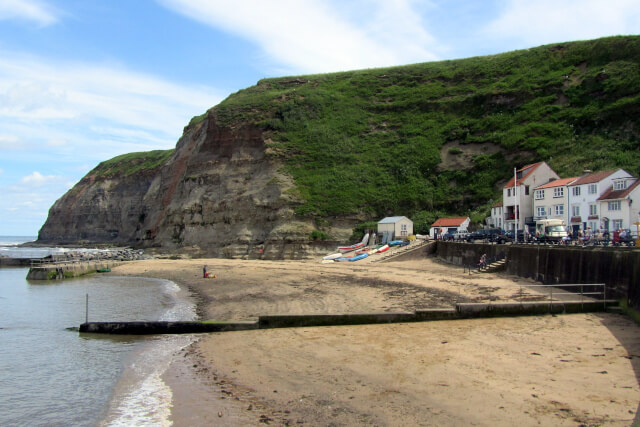
The Yorkshire Coast is one of the most reliable and rewarding regions for fossil hunting in the UK. Running from Staithes in the north to Flamborough Head in the south, the coastline exposes a rich sequence of Jurassic rocks that are packed with well-preserved marine fossils. The area is often referred to as the “Dinosaur Coast”, although most finds here come from ancient seas rather than land-dwelling species.
This part of the coast is especially known for ammonites, belemnites, fossilised wood and the occasional marine reptile remains, including ichthyosaurs. Regular cliff erosion and tidal movement bring new fossils to the surface, particularly after winter storms. Many beaches are easy to access and offer safe, open spaces for families and beginners to explore.
While much of the coastline is open to responsible collecting, some areas are designated as SSSIs or Heritage Coast, so care must be taken to follow local rules. Fossil hunting on the Yorkshire Coast combines scenic walks with the chance of finding well-preserved specimens, making it a popular choice for both casual visitors and experienced collectors.

• Runswick Bay (TS13 5HT) – A popular spot for finding ammonites, belemnites and plant fossils in loose shale along the foreshore.
• Staithes (TS13 5DB) – Offers a range of Jurassic marine fossils, including ammonites and fossil wood, often exposed after cliff falls.
• Robin Hood’s Bay (YO22 4SN) – Known for its abundance of ammonites and belemnites, along with occasional reptile fragments found in fallen rock.
• Whitby (YO22 4JX) – Perhaps most famous for Whitby Jet, Saltwick Bay offers the best chance at find this beautiful fossilised wood. Be sure to bring your bring your sandpaper so you can test whether you’ve actually found jet!
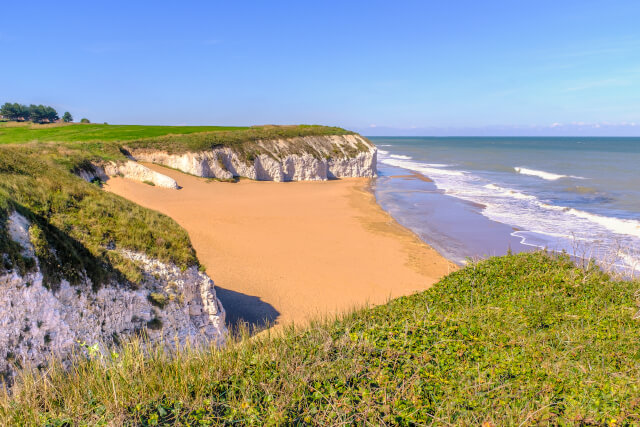
The Kent coast offers a unique fossil hunting experience, with a focus on finds from the Cretaceous period. Unlike other regions known for their Jurassic layers, Kent’s cliffs and foreshore areas are rich in Gault Clay and Chalk formations, which are well-known for preserving marine fossils. Erosion and tidal action frequently uncover new specimens, making it an accessible area for those looking to try fossil hunting in the UK.
This part of the coastline is especially noted for ammonites, bivalves, and fossil fish, as well as rarer finds like reptile bones, turtle remains and even fossil wood. The Kent beaches around Folkestone and the Isle of Sheppey are particularly productive, with large areas of exposed clay that are easy to explore at low tide. Much of the collecting here can be done by simply scanning the ground or gently sifting through loose material.
As with all fossil hunting locations, it’s important to collect responsibly. Some areas are protected, and cliffs can be unstable, so safety and legal access should always be considered. The Kent coast remains a popular destination for both new and experienced fossil hunters, offering a different range of finds compared to more well-known Jurassic sites.

• Folkestone Beach (CT20 2JP) – Well-known for Cretaceous fossils such as ammonites, bivalves and occasional reptile bones found in the exposed Gault Clay.
• Warden Point Beach, Isle of Sheppey (ME12 4HG) – Offers a mix of Eocene fossils, including turtle and crocodile remains, fossil wood and marine shells from eroded cliff material.
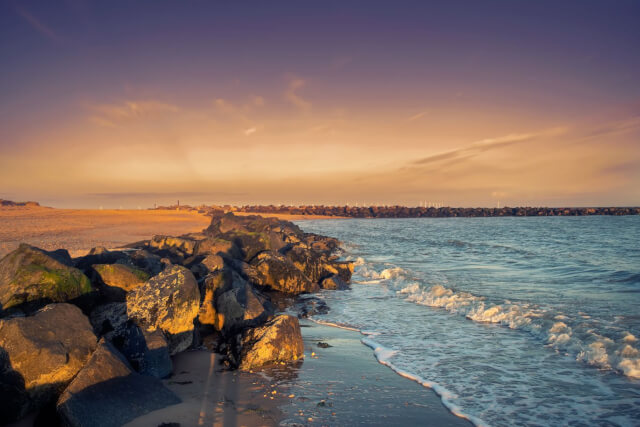
The Essex coast is a well-regarded fossil hunting region, particularly known for its abundance of Eocene fossils. Stretching along the north-eastern edge of the county, this area features soft cliffs and foreshore exposures where fossils are regularly revealed by erosion and tidal action. It’s especially popular for those searching for smaller but well-preserved specimens such as shark teeth and fossil wood; the perfect souvenir from your holiday!
Unlike rockier coastlines, the Essex foreshore is often muddy or clay-based, making it easy to explore and suitable for beginners and families. Fossils are commonly found loose on the surface or within small patches of clay and gravel. It’s an excellent location for introducing children to fossil hunting in the UK, as finds can often be made with little equipment or effort. It really is a great, free day out in the UK!
Responsible collecting is essential here, as the cliffs are prone to erosion and some areas are environmentally sensitive. As always, collecting from fallen or loose material is encouraged, and any significant finds should be reported to local experts or museums. The Essex coast provides a rewarding and accessible fossil hunting experience, particularly for those interested in marine life from the Eocene period.

• Walton-on-the-Naze Beach (CO14 8AS) – A well-known site for collecting Eocene shark teeth, fossil wood and shells eroded from the London Clay cliffs.
• Steeple Bay (CM0 7RS) – Offers occasional finds of fossil shells and plant material, often spotted in the clay banks and foreshore mud.
• Maylandsea (CM3 6AL) – A quieter location where patient searching can reveal small marine fossils, including molluscs and fragments of fossilised wood.
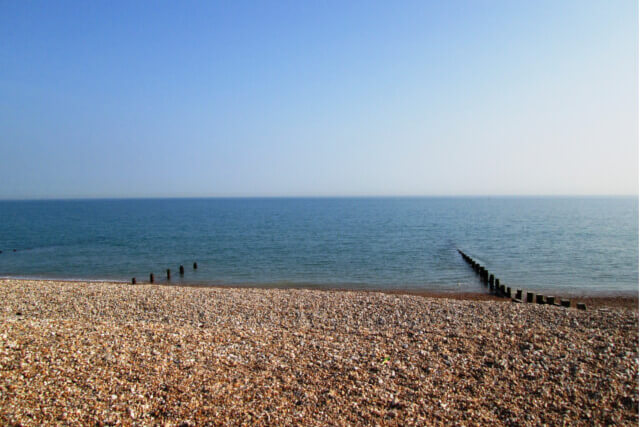
The West Sussex coast is a productive and accessible area for fossil hunting, particularly known for its Eocene deposits. The shoreline between Selsey and Bracklesham is especially rich in fossils thanks to the presence of the Bracklesham Beds, a formation that regularly yields marine fossils from around 45 million years ago. The natural tidal erosion along the gently sloping beaches also helps to expose new specimens on a regular basis.
This region is well-suited to beginners and families due to its flat terrain and ease of access. Fossils can often be found lying loose on the surface at low tide, without the need for digging or specialist tools. Finds commonly include shark and ray teeth, fish vertebrae, molluscs and other marine life from the Eocene period.
As with all UK fossil beaches, it’s important to follow safe and responsible collecting practices. Always check tide times before heading out, stick to accessible areas, and avoid disturbing any cliffs or protected zones. The West Sussex coast remains a popular destination for fossil hunting in the UK, offering an easy introduction to the hobby with a good chance of finding something interesting on most visits.

• Bracklesham Bay, Chichester (PO20 8JH) – A well-known Eocene site where shark teeth, ray plates and fossil shells are regularly found on the foreshore at low tide.
• Bognor Regis (PO21 1NX) – Offers occasional Eocene marine fossils, including molluscs and fish remains, particularly after storms or strong tides.
• Hastings Beach (TN34 3AD) – Known for occasional finds of fossilised plant material and fish remains from the Wealden Beds, exposed in cliff sections and rockfall areas.
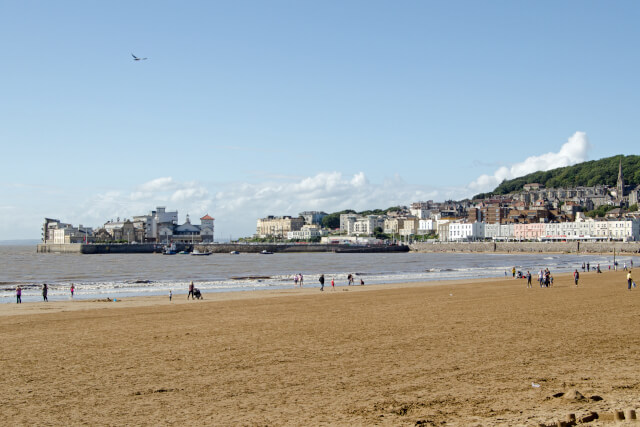
The North Somerset coast offers a rich and varied fossil hunting experience, particularly along the stretch between Watchet and Lilstock. The area is best known for its exposures of Blue Lias and Lower Jurassic rocks, which date back around 200 million years. These layers are packed with marine fossils and are regularly revealed through natural erosion along the cliffs and foreshore.
Fossil hunting in this region is often focused on ammonites, bivalves and crinoid stems, with occasional finds of ichthyosaur bones and fish remains. The beaches here are more rugged and rocky than in some southern regions, but the exposed strata make it a rewarding place to explore for those with a keen eye. Many fossils can be found loose among the rocks or within fallen nodules.
The area is generally open to responsible collecting, though visitors should avoid damaging cliffs or digging into stable rock faces. Tide awareness is crucial here, as the sea comes in quickly and can cut off access points.

• Weston-super-Mare Beach (BS23 4NH) – Known for occasional Jurassic fossils, including ammonites and bivalves, which are often found in the loose material along the foreshore.
• Watchet Beach (TA23 0AW) – A popular site for ammonites, crinoids and fossilised fish remains, regularly exposed in the Blue Lias clay and fallen rocks.
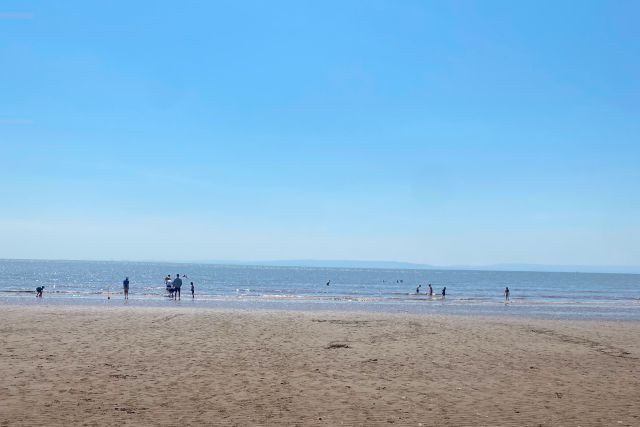
The South Wales coast offers a unique opportunity for fossil hunting in the UK, particularly for those interested in older geological periods. The region’s coastal exposures include rocks from the Ordovician, Silurian and Carboniferous periods, making it one of the best places in Britain to find ancient marine fossils. These rocks can contain remains that are over 400 million years old, including some of the earliest known sea life.
This area is best known for fossils such as trilobites, brachiopods, corals and crinoids, preserved in hard limestone and shale. The beaches between Barry and Llantwit Major are particularly productive, with natural erosion helping to reveal new finds. While many fossils are found within fallen slabs or scree at the base of cliffs, it is still possible to spot loose specimens along the foreshore.
As with any fossil site, safety and responsible collecting are essential. The cliffs can be unstable in places, and the tide can rise quickly along this stretch of coast. Visitors should avoid hammering into solid rock and focus on collecting from loose or exposed material. The South Wales coast provides a fascinating insight into ancient marine environments, making it a rewarding location for fossil hunters with an interest in older geological formations.

• Llantwit Major Beach, Vale of Glamorgan (CF61 1YX) – A well-known site for finding Carboniferous corals, brachiopods and crinoid stems in the limestone foreshore.
• Barry Island Beach (CF62 5AH) – Offers occasional marine fossils such as brachiopods and bivalves, typically found in weathered rocks and foreshore debris.
• Penarth Beach (CF64 3AU) – Known for Jurassic fossils including ammonites, belemnites and occasional reptile remains exposed in the grey cliffs and loose slabs.
Yes, fossil hunting is legal in most parts of the UK, provided that it’s done responsibly and in line with local access rules.
You don’t usually need a permit to collect loose fossils, but digging into cliffs, rock faces or protected sites may require permission, either from the local authority or environmental agencies/organisations.
Ammonites are among the most common fossils found in the UK, particularly along the Jurassic Coast.
Look for patterns, ridges or spirals that differ from the surrounding rock, and check if the texture or colour contrasts with the stone itself.
Yes, you can take loose fossils home from most public beaches, as long as collecting is allowed and you avoid damaging the site.
You don’t have to report common finds, but rare or scientifically important fossils should be reported to a local museum or geological expert.
Find even more amazing coastal hotspots with our comprehensive guide covering the best beaches in the UK. Or, if you’re simply looking for even more exciting hobbies and activities to get stuck into, take a look at this guide on the best outdoor activities in the UK! For those of you that are ready to book your next break, then we’d highly recommend heading over to this collection of coastal holiday cottages!
I'm Rob and I joined the Sykes team in February 2024. I am a passionate writer and have always enjoyed holidays in the UK, especia...
Read More About Author
Sign up to receive exclusive offers, competitions and the latest news to your inbox, and you'll be entered into our monthly prize-draw 3 times!

Bordering the Irish Sea and spanning three counties, these beaches in the North West make for excellent places to...

If you are looking to explore the UK’s stunning coastline and want to know what you can find hidden...

If you’re staying in Newcastle for your next city break, you and your guests can still enjoy all the...
Sign up to receive discounts, exclusive offers, travel tips and guides. We'll also enter you into monthly Prize draw. T&Cs apply. View Privacy Policy.
Are you on the phone to our call centre? Your Customer ID is:

Get involved in the Discussion